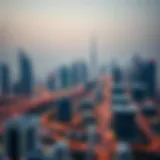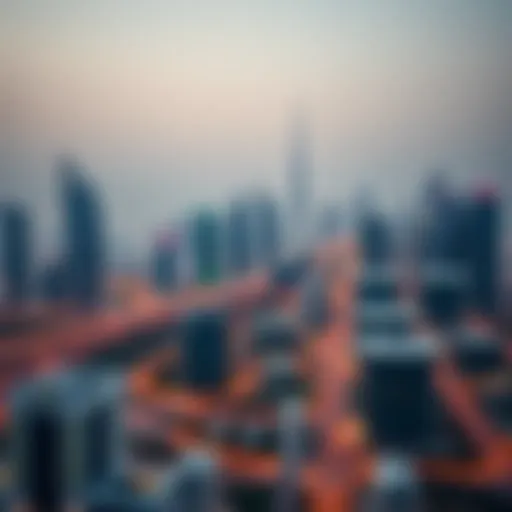Exploring the Architectural Essence of Terraces in Dubai
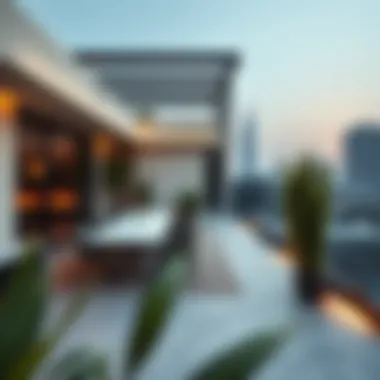

Intro
Terraces have become a hallmark of Dubai's urban landscape, serving both aesthetic and functional purposes. As the city has evolved, so too have the designs and uses of terraces, reflecting the vibrant culture and architectural experimentation that define modern Dubai. This exploration aims to shed light on how terraces fit into the broader context of architecture in Dubai while also addressing their historical roots, practical applications, and cultural significance.
Once predominantly viewed as mere outdoor spaces, terraces in Dubai have transformed into dynamic extensions of both residential and commercial properties. They encapsulate the essence of modern living, encouraging community interaction and promoting a sustainable lifestyle. The integration of terraces into architectural designs also speaks to the larger trends in real estate—where outdoor living is no longer an afterthought, but a central feature.
Understanding the architectural essence of terraces in this bustling metropolis is crucial for investors, homeowners, and real estate developers alike. With a keen eye on market trends and lifestyle integration, this article delves into the significance of terraces, illuminating their role as more than just design elements but as pivotal aspects of enhancing urban quality of life.
Preface to Terraces in Dubai
Terraces in Dubai are much more than mere architectural appendages; they encapsulate a fusion of aesthetic consideration and functional design. The idea to integrate terraces into residential and commercial buildings has grown in recognition, marking them as a quintessential element in Dubai’s urban landscape. They’re not just spaces for relaxation or social gatherings; they have evolved into critical aspects of lifestyle offerings that appeal to both residents and tourists.
The prominence of terraces can be attributed to several factors, including climate, cultural practices, and a local desire for outdoor living. In a city where the sun shines brightly almost year-round, a well-designed outdoor space can add immense value to a property. Not to forget, they provide opportunities for greenery, which in an urban setting is increasingly important.
For future homeowners, investors, and real estate agents, understanding the significance of terraces is invaluable. They not only enhance the beauty of properties but also provide an avenue for social interactions and leisure activities. Moreover, terraces can influence the overall market values of buildings, as properties featuring elegantly designed terraces are often sought after.
Definition and Importance
To put it simply, a terrace is a flat open space that serves as an extension of the living area, often located on the upper levels of structures. These spaces can vary widely, depending on design choices and intended use. Defined by architectural standards, terraces serve many practical purposes, such as offering panoramic views, providing outdoor environments for gatherings, or even serving as unique gardening spaces.
Their importance can’t be overstated, particularly in a locale like Dubai where maximizing outdoor utility is essential. Whether it’s for hosting social events or simply enjoying serene evenings under the stars, terraces enhance the living experience remarkably.
Historical Context
The history of terraces in Dubai is intertwined with the rapid urbanization this city has experienced over the last few decades. Early structures largely depended on traditional Arabic designs, which utilized shaded outdoor spaces to cope with the harsh local climate. The wind towers of old, along with raised platforms, served to create a cool environment where families could congregate and socialize, laying the foundation for modern terrace culture.
As Dubai embarked on its journey toward becoming a global city, more contemporary approaches began to emerge in architecture. Modern-day developments have adopted sleek lines and minimalistic styles, yet still keep the essence of outdoor living at the core. The combination of traditional influences and modern aesthetics creates a unique blend that characterizes Dubai's architectural landscape.
An example of this is the Burj Khalifa, whose terraces provide an opulent vantage point, allowing visitors to admire the cityscape below. The city's vibrant culture is reflected in its terrace designs; some feature lush gardens reminiscent of the old days, while others boast cutting-edge materials and technology. This evolution mirrors the ethos of Dubai itself: a city embracing its roots while striding confidently toward the future.
The essence of terraces in Dubai is not just about leisure; it’s an architectural narrative that tells the story of a place—its climate, culture, and ambitions.
In summary, as we delve deeper into the architectural essence of terraces in Dubai, it becomes evident that they are a fundamental aspect of the city’s identity and development. Understanding their multifaceted roles opens doors for real estate enthusiasts and investors, shedding light on their significance in the bustling property market.
Architectural Styles of Terraces
Terraces in Dubai serve more than just a functional purpose; they are architectural statements that reflect the city’s rich cultural tapestry and its commitment to innovation and sustainability. Each style of terrace contributes uniquely to the overall aesthetic of the buildings and the communal environment. In this section, we delve into various architectural styles of terraces and explore how they fit into the broader context of Dubai's urban development.
Traditional Arabic Terraces
Traditional Arabic terraces are deeply rooted in the cultural heritage of the region. Often characterized by intricate latticework and shaded areas, these terraces reflect a practicality shaped by the desert climate. They typically feature low walls adorned with vibrant tiles and offer an open-air space where family and guests can gather.
One of the most notable aspects of traditional Arabic terraces is their emphasis on privacy and seclusion, often a consideration in Middle Eastern architecture. The use of architectural elements like mashrabiya, a type of wooden lattice screen, enables air circulation while obstructing direct views from neighboring properties. This creates a comfortable environment for outdoor activities, making these terraces not just spaces for leisure but essential extensions of homes.
The presence of plants and flowers in traditional Arabic terraces adds to their charm. Incorporating greenery not only beautifies the space but also aids in cooling, making it a prime choice for alfresco dining or evening gatherings. Such terraces can also facilitate a rich connection to cultural traditions, as communal meals and socialization are pivotal in Arabic cultures.
Contemporary Designs
As Dubai constantly evolves, so do its architectural styles. Contemporary designs of terraces reflect a modern sensibility, focusing on minimalism and functionality. These terraces often feature sleek lines, open spaces, and extensive use of glass and steel, blending seamlessly with the high-rise skyline of Dubai.
Urban residents often favor contemporary terraces for their ability to maximize space in compact apartments and condos. Typical features include modular furniture, integrated lighting systems, and outdoor kitchens, allowing for year-round enjoyment. These terraces also extend living spaces into the outdoors, which is an essential aspect of the city’s urban lifestyle.
Among the highlights of contemporary terrace designs in Dubai is the incorporation of smart technology. Automated systems for lighting, irrigation, and climate control are becoming standard. Many terraces directly integrate these technological advancements, providing owners a tailored outdoor experience that is both luxurious and sustainable.
Eco-friendly Terraces
In recent years, the trend towards sustainability has taken root in Dubai’s terrace designs. Eco-friendly terraces are not merely a passing fad; they represent a significant shift towards responsible architecture. These designs often make use of native plant species and recycled materials, creating green spaces that support biodiversity while reducing ecological footprints.
Moreover, eco-friendly terraces frequently incorporate systems for rainwater harvesting or solar panels. This functionality addresses both irrigation and energy needs, essentially marrying aesthetic beauty with environmental responsibility. The result is a terrace that offers a retreat from the bustling city, promoting relaxation and mindfulness in an increasingly hectic world.
Notably, community-focused eco-friendly terraces also encourage social interaction among residents. Rooftop gardens and shared green spaces become common grounds for community events or farmer's markets, fostering a sense of belonging in urban living.
Terraces designed in this eco-conscious manner contribute significantly to the overall sustainability goals of Dubai, aligning with government initiatives aimed at reducing environmental impact.
"The integration of ecology and architecture not only enhances urban living but also reflects a global shift towards environmental awareness."
In exploring the architectural styles of terraces in Dubai, it’s evident that each style carries its significance, steeped in culture or innovation. From the rich heritage of traditional Arabic terraces to contemporary designs and eco-friendly innovations, one can see how these spaces are evolving while remaining a unique facet of the emirate's architectural identity.
Functional Aspects of Terraces
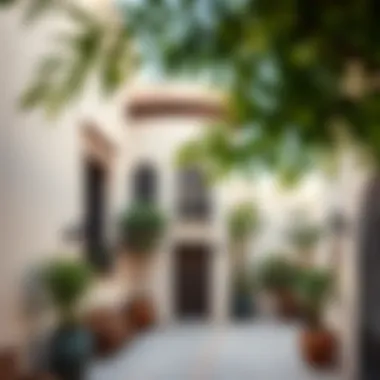

Terraces serve more than just an aesthetic purpose in Dubai's architectural landscape. They play a crucial role in enhancing the quality of urban life, offering various functional benefits that cater to the needs of residents and investors alike. Understanding the functional aspects of terraces can provide insights into their significance in promoting outdoor living, facilitating gardening opportunities, and enriching views and aesthetics.
Outdoor Living Spaces
Outdoor living spaces on terraces create an extension of indoor areas. This trend has gained momentum as residents seek to connect with nature while enjoying the sky above.
Terraces allow for the establishment of relaxation zones, dining areas, and lounging spots. In regions like Dubai, where climate conditions are often favorable, these spaces become vibrant social hubs during cooler months. Equipped with shade structures, comfortable furniture, and lighting, outdoor lounges effectively transform the terrace into a mini getaway.
Here are several characteristics that highlight the versatility of outdoor living on terraces:
- Flexibility: Homeowners can customize their terraces based on personal preferences. From minimalist designs to lush, landscaped spaces, the options are extensive.
- Social Interaction: Terraces can host gatherings, barbecues, and family celebrations, creating a welcoming atmosphere for friends and loved ones.
- Accessibility: Having a terrace means easy access to outdoor space from wherever in the home provides convenience and encourages more outdoor time.
Gardening Opportunities
Gardening has become a significant pursuit among Dubai's urban dwellers. Terraces act as perfect platforms for creating green spaces in densely populated areas. Homeowners increasingly embrace the idea of crafting lush gardens that not only beautify their living environment but also contribute to sustainable practices.
Gardening on terraces can include everything from small herb pots to expansive vegetable gardens. Here are some points illustrating its importance:
- Fresh Produce: Growing fruits and vegetables on a terrace can lead to healthier eating habits. It allows residents to enjoy fresh produce right at home, reducing reliance on supermarkets.
- Biophilic Benefits: The presence of plants improves air quality and provides psychological gains, making space feel more welcoming and calming.
- Creative Uses: Vertical gardens and container gardening are popular options for terrace spaces, maximizing the use of limited areas while also allowing for creativity and personalization.
Views and Aesthetics
One cannot overlook the visual impact that terraces contribute to both individual properties and the overall skyline of Dubai. The views from terraces can be breathtaking, particularly when they frame iconic landmarks or provide panoramic cityscapes.
Focusing on aesthetics not only enhances personal enjoyment but also increases property value. Consider these factors when evaluating terrace views:
- Scenic Value: A high-rise building’s terrace provides unmatched perspectives of the surrounding landscape, creating a unique selling point for potential buyers.
- Design Cohesion: The aesthetic integration of terraces with the architectural style of the building creates a more harmonious overall appearance. Thoughtful design and materials can elevate the beauty of both terraces and the structures to which they're attached.
- Visual Appeal: Well-designed terraces can attract attention, encouraging a sense of luxury and style for both residents and visitors.
"A terrace is not just a physical extension of the home; it's a gateway to the exterior world, blending inner serenity with outer beauty."
Through analyzing these functional aspects, we can appreciate how terraces enrich the urban living experience. They provide essential outdoor living areas, gardening opportunities, and picturesque views, ultimately contributing to the dynamic lifestyle offered in Dubai's bustling environment.
Terraces and Community Integration
Terraces in Dubai contribute significantly not just to the aesthetics of buildings but also play a vital role in enhancing community life. They serve as important transitional spaces that bridge the private sanctum of homes with the public vibrancy of neighborhoods. Effective community integration through terraces helps foster social interactions and contributes to a sense of belonging among residents.
Having terraces as part of architectural designs offers a variety of benefits. They can enhance the overall livability of neighborhoods by encouraging outdoor activities, which is particularly important in Dubai's climate. Moreover, terraces facilitate interaction among residents, creating informal gathering spaces that mitigate the solitude often experienced in urban living. This aligns with Dubai's aim to develop more cohesive communities.
Public vs. Private Terraces
Understanding the distinction between public and private terraces is fundamental for grasping their role in community integration. Public terraces typically form a part of community buildings or parks, made accessible to everyone. They can be designed with amenities like seating areas, landscaped gardens, or even small fountains, enhancing overall community aesthetics and offering spaces for recreational activities.
Conversely, private terraces cater to individual families or property owners. These spaces may provide a secluded sanctuary for relaxation and offer a retreat while still allowing residents to stay connected with the outside world. In some high-rise buildings, for instance, these can be utilized as exclusive spots for barbecues or gatherings, reinforcing family bonds or even neighborly connections.
- Public Terraces:
- Private Terraces:
- Accessible to all community members
- Promote social interaction
- Often designed with amenities for recreation
- Offer seclusion for families
- Flexible usage for personal events or gatherings
Social Spaces
The importance of terraces extends to their function as social spaces. These areas allow for casual interactions among residents, whether it’s sharing a cup of coffee with a neighbor or hosting a small get-together during festive occasions. Such connections are vital as they foster a spirit of community and engagement, especially in a city like Dubai, which is characterized by its rapidly evolving population.
Moreover, the positioning and design of these social areas influence how residents perceive their community. Terraces that are welcoming and well-designed can become focal points where community events or celebrations take place. This not only strengthens neighborly ties but also cultivates a vibrant community culture that reflects the diverse fabric of Dubai.
In summary, terraces can be the heartbeat of community integration, providing necessary space for both private reflection and public interaction. Whether public or private, their careful design can greatly enrich the communal atmosphere, benefiting both residents and investors in understanding their value in the overall urban environment.
Regulatory Framework Governing Terraces
The design and construction of terraces in Dubai don’t happen in a vacuum. They are deeply intertwined with a regulatory framework that ensures safety, aesthetic coherence, and integration with the urban fabric. Understanding this framework is essential for investors, homebuyers, agents, and developers looking to navigate the complexities of Dubai's real estate landscape. Having a grasp of the rules that govern terrace construction not only protects stakeholders but enhances the value of properties underpinned by solid architectural practices.
Building Codes
Building codes are akin to the backbone of terrace construction—setting the standards for safety, quality, and sustainability. These codes dictate everything from the materials used in the construction to the load-bearing capacities of terraces. They ensure that structures can withstand the intense heat and occasional storms that characterize Dubai's weather. Without these regulations, we would likely see a patchwork of poorly designed and potentially unsafe terraces.
In Dubai, the Dubai Municipality is responsible for establishing and enforcing these building codes. They periodically update regulations to keep pace with technological advancements and environmental changes. For instance, the introduction of green building codes encourages developers to incorporate sustainable materials and energy-efficient designs, benefiting both the environment and the occupants.
Some of the specific requirements under current building codes include:
- Structural Integrity: Terraces must be designed to handle weight loads correctly, considering factors like furniture, plants, and even occupants.
- Safety Features: Guardrails, non-slip surfaces, and accessibility standards are implemented to ensure safety.
- Insulation and Ventilation: Proper thermal insulation is vital to minimize energy consumption. Ventilation systems are also mandated to create comfortable outdoor spaces.
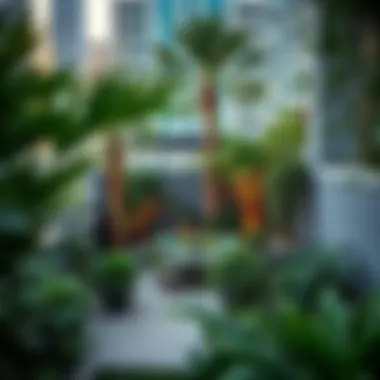

Keeping abreast of these codes is not just a formality; failing to comply can lead to hefty fines and potentially jeopardize an investment. Moreover, adhering strictly to these regulations can significantly improve the marketability of properties, making them more attractive to potential buyers.
Zoning Laws
Zoning laws represent another layer of regulatory oversight, zoning not only serves to organize urban development but also to enhance the livability of outdoor spaces. In Dubai, zoning laws dictate where properties can be located and their intended use—residential, commercial, or mixed-use. Such laws often specify the types of terraces that can be constructed, including height restrictions, allowable features, and the integration of green spaces.
Understanding zoning regulations is crucial for developers who want to optimize their projects for potential return on investments. For example, terraces on commercial properties might need to adhere to different regulations compared to those on residential units. This distinction impacts design decisions, amenities included, and even the target demographic for a property.
Some key aspects of Dubai's zoning laws affecting terraces include:
- Permitted Heights: Regulations often prescribe maximum heights for outdoor structures to maintain aesthetic standards and sightlines from public spaces.
- Setback Requirements: These require a certain distance from the property line for safety and privacy, influencing how a terrace is laid out.
- Land Use Designations: Zoning often dictates what type of environments are suitable for terrace construction, affecting projects in bustling districts versus quieter residential areas.
In summary, a well-informed grasp of both building codes and zoning laws not only keeps projects compliant but also enhances the aesthetic charm and community integration of terraces. A property that conforms to the regulations speaks volumes about its quality and appeal, often translating to solid returns in the competitive Dubai real estate market.
"Awareness of regulatory frameworks enhances property value while ensuring safety and sustainability in architectural endeavors."
For detailed information regarding Dubai’s building codes and zoning laws, consider consulting the official Dubai Municipality website or resources such as Wikipedia and Britannica.
Terraces in Real Estate Investment
The significance of terraces in the realm of real estate investment cannot be overstated, particularly in a city as dynamic and growing as Dubai. With developers constantly searching for ways to enhance property value and attract potential buyers, terraces offer a unique blend of aesthetic appeal and functional use. This contributes to a more comprehensive understanding of the market landscape.
Terraces serve as an extension of living spaces, blurring the lines between indoor and outdoor environments. This integration greatly appeals to today's homebuyers, who are often inclined toward open layouts and natural ambiance. Moreover, terraces can contribute significantly to the overall charm of properties, providing elegant vistas that increase desirability. As a result, properties with well-designed terraces often command higher prices.
Market Trends
Now, let’s take a closer look at market trends surrounding terraces in Dubai. Over recent years, the demand for terrace space has peaked, influenced by a surge in urbanization and changes in lifestyle preferences. This evolution reflects a heightened awareness of sustainable living and outdoor leisure. Numerous high-rise buildings now boast terraces, not just as luxuries but as essentials for modern living.
- Emerging Preferences: Buyers are increasingly seeking homes that allow for leisure and relaxation outside. Terraces, offering these options, are a strong sell.
- Market Shifts: New developments are integrating terraces within their designs from the ground up. This trend signals a departure from the utilitarian approach of the past towards a more lifestyle-driven focus.
- Investment in Amenities: Developers who incorporate terrace spaces may find a growing investor interest, as such features enhance the potential for rental income.
With such trends in mind, it’s clear that terraces are not merely accessories but integral parts of property value considerations.
Investment Value
When it comes to the investment value of terraces, several points stand out. First off, properties featuring terraces generally experience a notable appreciation in value. Here are some key factors reflecting their investment value:
- Enhanced Living Experience: Terraces add perceived value, providing homeowners with spaces for relaxation, gatherings, or gardening without the need for expansive grounds.
- Increased Marketability: In competitive markets, properties with terraces tend to sell faster. Buyers are willing to invest more for homes that meet their lifestyle needs, which include outdoor spaces.
- Potential for Versatility: Investors can also see terraces as opportunities for diversification. Whether for personal use or rental, their adaptability can generate additional income.
"Terraces have become a key selling point in the real estate market, merging aesthetics with valuable outdoor functionality."
In summary, for anyone looking at the landscape of Dubai real estate, terraces represent more than just architectural features; they embody a trend that aligns with modern living preferences and sustainability. Real estate investors and homeowners alike would do well to recognize that terraces could fundamentally influence their property’s overall value.
Sustainability and Terraces
Sustainability takes center stage in contemporary architecture, especially in a rapidly evolving urban landscape like Dubai. Terraces, in particular, are pivotal for integrating green concepts into both residential and commercial properties. They provide opportunities to enhance ecological balance while offering a serene retreat from the bustling city life. As investors and homebuyers look for properties that embody sustainability, terraces serve as a beacon indicating adherence to eco-friendly practices.
Green Designs
When we talk about green designs in terraces, we're touching on concepts like vertical gardens, native landscaping, and sustainable materials. By opting for local flora, homeowners can minimize water usage and maintenance costs. The implementation of vertical gardens, in particular, has skyrocketed in popularity. They not only purify the air but also reduce the urban heat island effect, making terraces cooler and more enjoyable during the blistering summer months.
- Use of native plants that require less water
- Incorporation of biodegradable materials in construction
- Installation of green roofs to absorb rainwater
The benefits are manifold. These green spaces act as biodiversity hotspots in the urban jungle, providing habitats for various species while serving as educational platforms for residents about sustainable living.
Energy Efficiency
Energy-efficient terraces play a crucial role in reducing the carbon footprint of a building. Strategically designed balconies can maximize natural light and ventilation, which decreases the reliance on artificial lighting and air conditioning. This strategy is not just beneficial for the environment; it translates into substantial savings on utility bills for homeowners.
Terraces designed with overhanging roofs and shaded areas help regulate temperature variations indoors. By reflecting sunlight, lighter-colored surfaces further reduce heat absorption, enhancing overall comfort. In this instance, it’s not just about aesthetics; it's about creating a livable environment that promotes well-being while safeguarding the planet.
The integration of solar panels and energy-efficient appliances on terraces is becoming more commonplace, turning these spaces into powerful contributors to energy conservation.
Water Management Techniques
Water management is another critical focus in the design of terraces. Implementing rainwater harvesting systems can make a significant impact on reducing water consumption for irrigation. Homeowners can create systems that collect runoff from terraces, channeling it to storage containers or rain gardens.
- Permeable pavement: By utilizing porous materials, terraces can allow rainwater to seep through, reducing runoff and promoting groundwater recharge.
- Drip irrigation systems: These systems efficiently water plants with minimal waste, ensuring that every drop counts.
By creatively incorporating these water management techniques, properties not only become more eco-conscious but also enhance their market value. This foresight satisfies the increasing demand from discerning buyers for homes that are not only beautiful but also environmentally responsible.
In summary, sustainability and terraces represent a harmonious blend of innovation and tradition. By marrying green designs, energy efficiency, and effective water management, Dubai’s terraces can be both functional and environmentally responsible. These design choices are not just good for the planet; they’re attractive investments for anyone keen on making their homes and businesses stand out in an ever-competitive market.
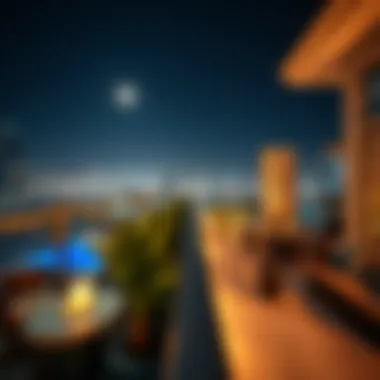

"Investing in sustainable terrace designs isn't just a trend; it's a commitment to the future, one that yields returns both financially and ecologically."
For further reading on sustainability in architecture, check out resources from Wikipedia and Britannica.
Technological Advances in Terrace Design
In the fast-paced urban environment of Dubai, terraces have evolved far beyond mere outdoor spaces. Technological advancements play a crucial role in enhancing the functionality and aesthetics of terraces, making them indispensable assets in both residential and commercial properties. The integration of technology in terrace design not only elevates the living experience but also promotes sustainability and efficiency, aligning with Dubai's commitment to innovation and modernity.
Smart Features
Smart features have revolutionized the way we interact with our outdoor spaces. These elements include automated irrigation systems, integrated lighting solutions, and remote-controlled shading devices. Imagine a terrace that waters your plants on a schedule, ensuring they thrive without the need for manual intervention. Automation can be tailored to individual preferences, enabling homeowners to set specific times for watering or adjust lighting based on the time of day.
Furthermore, smart environmental sensors can monitor temperature and humidity, optimizing the outdoor climate for comfort. Have you ever thought about enjoying a cool evening breeze without lifting a finger? Smart thermostats can adjust outdoor heating or cooling systems accordingly—with just a tap on your smartphone.
The benefits of such technologies extend beyond convenience. They enhance energy efficiency and promote sustainability. By using smart irrigation systems, homeowners can significantly reduce water wastage. Compliance with environmental regulations becomes easier as terraces contribute to a greener urban landscape, supporting the eco-friendly ethos prevalent in Dubai.
"Smart technologies in terrace design offer a glimpse into a future where comfort and sustainability coexist seamlessly."
Innovative Materials
The choice of materials has a profound impact on both the functionality and aesthetic appeal of terraces. Innovative materials such as composite decking, treated woods, and recycled materials are gaining traction in the market. A significant advantage of composite materials is their durability—they withstand the harsh UAE climate without fading or rotting, making maintenance a breeze.
Moreover, sustainable materials, such as bamboo and recycled plastics, are increasingly being used in terrace construction. These choices not only minimize the environmental footprint, but they also create unique spaces that resonate with eco-conscious buyers.
For those looking to enhance the aesthetic value of their terraces, choices like glass railings can offer unobstructed views, allowing residents to enjoy the stunning surroundings of Dubai without physical barriers. The use of photovoltaic panels to harness solar energy in terrace design has also gained prominence. These panels contribute to energy needs, making terraces more than just beautiful spaces—they transform them into energy-generating assets.
By embracing innovative materials and design methodologies, terraces can reflect the luxurious modern lifestyle of Dubai while promoting environmental sustainability.
In summary, technological advancements in terrace design not only enhance functionality and aesthetics for investors and homeowners but also emphasize the significance of sustainability in today’s architectural endeavors. Whether through smart features or innovative materials, the potential of terraces in Dubai is truly vast.
Cultural Significance of Terraces
In the intriguing landscape of Dubai, terraces are not merely functional spaces; they represent a canvas for cultural expression and identity. Given the rapid tempo of urban development, terraces serve as a symbol of continuity amidst change. They embody the way culture shapes our experiences in outdoor environments.
Cultural Expressions
The cultural relevance of terraces in Dubai can be seen in how they become extensions of living spaces, reflecting the values and traditions of different communities. For instance, many homeowners decorate their terraces with elements of traditional Arabic design, incorporating intricate mashrabiya patterns that offer both beauty and privacy. Such designs resonate with the heritage of the residents, turning their terraces into personal showcases of culture.
- Colorful Furnishings: Outdoor cushions in vibrant hues, seen on many terraces, are not just for comfort. They signify the Middle Eastern penchant for hospitality and warmth toward guests.
- Local Flora: Planting native species like date palms on terraces enriches the cultural landscape, blending nature with urban living. This practice is often seen as an homage to the region's historical relationship with agriculture.
- Cultural Gatherings: Terraces are spaces where familial and community bonds are strengthened. During Ramadan, many families use their terraces for iftar meals, showcasing how these outdoor areas are vital for cultural celebrations and socialization.
Tradition Versus Modernity
As Dubai evolves, the design of terraces reflects varying dynamics between tradition and modernity. The juxtaposition of traditional designs alongside contemporary aesthetics reveals a city in dialogue with its past while embracing the future. This tension is evident when you consider the following:
- Architectural Fusion: Many new developments feature terraces designed with a sleek, minimalist look, deviating from ornate styles but incorporating local elements. For instance, a modern high-rise might use panoramic windows to frame a view while echoing the traditional balcony layout.
- Lifestyles Influenced by Global Trends: Increasingly, residents are adopting international outdoor living trends. This has led to seamless integration of modern amenities in terrace spaces, such as outdoor kitchens and smart tech features, which contrast with age-old customs.
- Sustainability Meets Heritage: The push towards eco-friendly practices has spurred a new appreciation for traditional methods of terrace usage, such as pergolas and shading structures, harkening back to older, sustainable designs that utilized local materials and designs suited to the climate.
The cultural significance of terraces in Dubai illustrates a broader narrative about urban identity. They stand at the crossroads of heritage and innovation, influencing everything from community interactions to architectural styles.
Understanding this facet of Dubai's terraces enriches the overarching theme of this exploration, emphasizing how architecture transcends mere structure to become a reflection of community and culture.
Future of Terraces in Dubai
The future of terraces in Dubai is a topic that brings together various threads of urban planning, architectural innovation, and lifestyle enhancement. As the city continues to grow at a breakneck speed, terraces are poised to play a crucial role in how spaces are utilized, combining functionality with aesthetic appeal. The rise of sustainability, community integration, and technological advancements are all factors influencing this evolution. Considering the unique environment of Dubai, it becomes increasingly important to scrutinize the upcoming trends that would shape terraces.
Urban Development Trends
Dubai's urban landscape is one characterized by both ambition and adaptability. One of the key urban development trends impacting terraces is the push towards mixed-use spaces. Developers are increasingly focusing on integrating residential, commercial, and recreational areas within single projects. This blend allows for terraces to serve multiple purposes, from social gatherings to private retreats. The mixed-use model supports community engagement and fosters a sense of belonging, which is essential in a city known for its transient population.
Additionally, the implementation of vertical greenery is something one cannot overlook in discussions about future terraces. As cities grapple with urban heat and limited space, the upward expansion of green terraces seems more relevant than ever. Incorporating plants in terrace designs not only enhances aesthetics but also contributes to ecological stability by improving air quality and providing natural insulation. Furthermore, with a heightened focus on walkability, it’s evident that rooftops and terraces will be increasingly seen as extended outdoor spaces that bridge the gap between nature and urban living.
Benefits of Urban Trends for Terraces
- Enhanced Outdoor Experience: Terraces designed to engage with their surroundings can improve quality of life.
- Support for Local Businesses: Mixed-use developments can create foot traffic, benefiting cafes, shops, and services.
- Sustainability Measures: Green roofs contribute to energy savings and help mitigate urban heat.
Evolving Landscape
The evolving landscape of Dubai further indicates a direction towards not just more terraces but smarter ones. The infusion of technology into building practices has changed the dynamics of how terraces are conceived and integrated. Smart terraces equipped with IoT devices for monitoring things like temperature and humidity are gradually becoming a reality. This trend cultivates an optimized environment for both people and plants, enabling the implementation of more sophisticated gardening and leisure solutions.
Moreover, the evolving textures and materials used in terrace construction are moving towards sustainable choices. The awareness around energy-efficient materials that reduce the carbon footprint of construction projects brings about an exciting shift. Materials such as recycled steel and self-healing concrete may someday redefine what terraces look like in Dubai.
“The integration of renewable energy systems, such as solar panels on terraces, is also a critical consideration for future developments.”
Considerations for Future Developments
- Technological Integration: Anticipate innovations with energy-efficient options.
- Functional Design Elements: Consider how terraces can adapt to changing lifestyles and community needs.
- Aesthetic Appeal: Balance sustainability with visual elegance that resonates with the local culture.
In summary, the future of terraces in Dubai holds great promise, driven by urban trends and technological innovations. As urban planners, architects, and investors look ahead, they must keep a keen eye on these evolving aspects to make terraces a hallmark of modern Dubai living.
